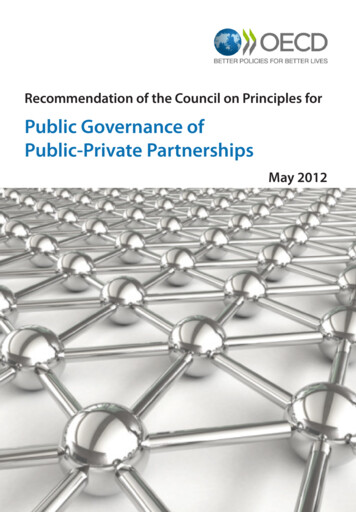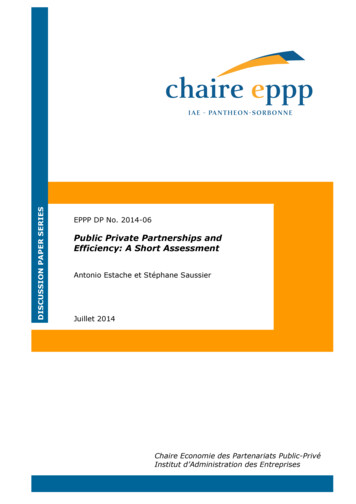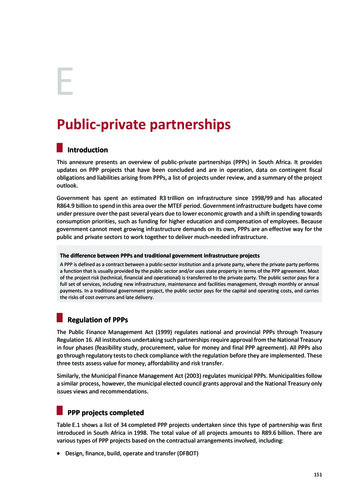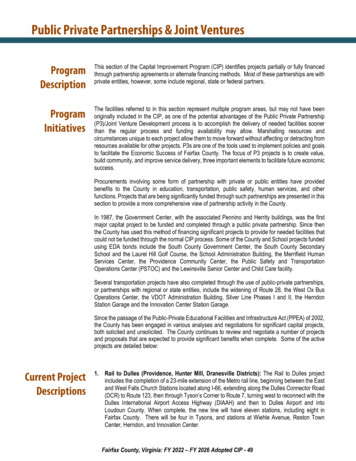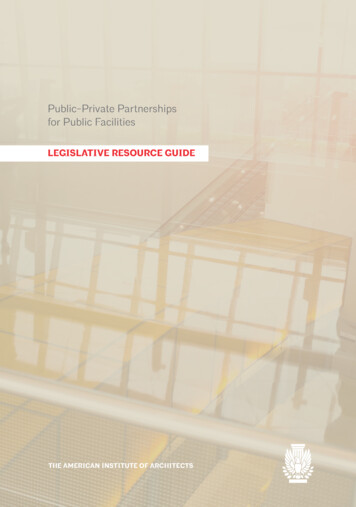
Transcription
Public-Private Partnershipsfor Public FacilitiesLEGISLATIVE RESOURCE GUIDETHE AMERICAN INSTITUTE OF ARCHITECTS
INTRODUCTIONThis Legislative Resource Guide (the “Guide”)was developed in recognition of the challengethat public entities face in meeting public facility infrastructure demands with constrainedbudgets.1 Public-private partnerships, usedproperly, can address this challenge by givingpublic entities the option to contract with private entities to provide design, build, finance,operate and maintain turnkey services whenthe building project meets certain criteria.Because private sector financing for publicworks raises rightful concerns for corruption and increased costs to the taxpayer, theprocess for engaging in these transactionsmust be transparent and should demonstrate a process that prioritizes quality overshort-sightedness, resource and risk sharingover unnecessary duplication of efforts andrisk exposure, and operational efficienciesover costly and wasteful spending. If enacted improperly without sufficient guidance,however, partnerships will unfortunately costtaxpayers more money and will eventuallypreclude the use of a legitimate, long-termsustainable project delivery method.The American Institute of Architects commenced researching the global legislativelandscape for public-private partnerships in2012. What we found is that for more thana decade, jurisdictions in the United States,especially with regard to horizontal infrastructure (civil works—roads, bridges, watertreatment), have engaged the private sectorin various ways to partner in the delivery ofpubic construction programs; some haveexplicit statutory authority, others piecemeal.Many US jurisdictions2 have begun to addressthe current “patchwork” statutory landscapewith comprehensive legislative enactmentsto enable public-private partnerships,unequivocally. Several other US jurisdictions are in the process of developing ordebating comprehensive statutory authority.3And others have limited authority for certainbuilding types or are in a “pilot” structure.4Countries such as Canada, Australia and theUnited Kingdom have utilized public-privatepartnerships for more than a decade for bothhorizontal and vertical infrastructure (public facilities). In those years, mistakes weremade and successes were had that beg theattention of lawmakers in the US. Learningfrom their experiences is an extraordinaryopportunity from which US jurisdictions canundoubtedly profit. The AIA has taken the lessons learned and incorporated them into thelegislative provisions herein.This Guide consists of a main section and twoappendices. The main section walks the reader through important elements in a successfulPPP law. Each element is accompanied by (1)background information explaining why theelement should be included in a PPP law, (2)sample legislative language that can be cut,pasted, and amended to suit an existing statutory context, and (3) a reference section forapplicable words or phrases that should bedefined. Appendix A provides recommendeddefinition language. Appendix B sets forth thesuggested legislation comprehensively.The Institute is engaged in a coalition-building effortwith national industry organizations whose expertise andmember-focus relates to horizontal public construction(roads, bridges, water, etc) in an effort to broaden thereach and desired application of these legislative provisions to both vertical and horizontal construction. In theinterim, these legislative provisions are intended only forvertical infrastructure (i.e. public facilities).1Including Virginia, Texas, Florida, Maryland, NorthCarolina, Oregon, Pennsylvania, Puerto Rico2Including Tennessee, New York, Kentucky, Georgia, Hawaii,Pennsylvania, Missouri, New Mexico, Colorado, Indiana,Arizona, Arkansas, South Carolina, District of Columbia3Including Connecticut, New Jersey, California, Kentucky,Colorado, South Carolina, Washington, Georgia4 For more information, please contact the AIA Local Government Division at govaffs@aia.org.AIA STATE PUBLIC-PRIVATE PARTNERSHIP ELEMENTS November 20141
OVERVIEW
OVERVIEWUnderstanding P3s: What Are They and How Do They Work?Public-Private Partnerships (“PPP”), as aconcept, can mean many different things. Ata very basic level it involves any contractualpartnership between a public and a privateentity. When this simple concept, however,is applied to the complex process of gettingpublic facilities built, a proverbial “iceberg”of issues beneath the surface should beconsidered. As with all construction projects for public use, there is an extensive andnecessary feasibility and planning processthat occurs prior to the design phase of theproject. After the feasibility and planningphase, numerous basic design conceptsare developed and considered with theclient end-user. Once the client-end userapproves the direction of the conceptualdesign, there’s an intensive design-development phase that involves transforming theconcepts and ideas into a physical form andstructure that is depicted in architecturalfloor plans, building elevations and sections.This back-and-forth design process with theend-user client will continue until the designs are developed to become the technicalinstructions to build with materials specifications, details and overlaying engineeringsystems (e.g. structural, mechanical, electrical, plumbing). Laws that acknowledge thiscomplex planning and design process beforeconstruction even begins will reap rewardsfor taxpayers and society.The process of codifying the concept(described above) is a critical first step. Weview the best definition to be one that setsreasonable parameters and incorporatesbest practices and lessons learned frompublic entities with real-world experiences.A codified public private partnership projectdelivery method for getting public facilities built should be “a long-term performance-based approach to procuring publicinfrastructure where the private sectorassumes a major share of the risks in termsof financing and construction and ensuringeffective performance of the infrastructure,from design and planning, to long-termmaintenance.”5 In more practical terms, thismeans the public entity typically:Has a single point of responsibility forthe design, construction, financing,maintenance, and sometimes the operation, of the asset;Does not pay for the asset until it is occupied;Pays the cost of the design and construction of the asset “over the life of theasset and only if it is properly maintainedand performs according to specifications. 6 and;Knows the costs for a long-term portionof the asset’s lifespan upfront, “meaningthat taxpayers are not on the financialhook for cost overruns, delays or anyperformance issues over the asset’s life.” 7PPP Canada, About P3s, Frequently Asked Questions,P3CANADA, ed-questions/ (last visited Nov. 17, 2014).56Id.7Id. For more information, please contact the AIA Local Government Division at govaffs@aia.org.AIA STATE PUBLIC-PRIVATE PARTNERSHIP ELEMENTS November 20142
By assuming long-term maintenanceresponsibility, the private entity is heldmore accountable for the delivered assetand is therefore incentivized to producea high-quality, long-lasting asset. Thepayment structure (a.k.a. the “availabilitypayment”) is performance-based, meaningthat payments are not made unless anduntil the asset is delivered and functioningat the standards specified in the contract.Using an output-oriented approach, wherethe public entity specifies what it wantsrather than how it wants it, maximizes opportunities for innovation and competitionand enables the private sector to developthe best solution.One of the advantages of PPPs is thatthey can provide public entities access toprivate capital, but with this access comesa heightened level of scrutiny (and rightfully so) to protect taxpayers. After all, PPPdoesn’t change the fact that the public isstill “on the hook” over the long-term forpaying for the project. By having a legislative framework that is consistent andpredictable, it will provide transparency andenable the private market to gauge the risksand rewards.Because PPP projects should be longterm business transactions for the reasonsdescribed above, their use requires carefulconsideration, significant public capacity,and sufficient private market interest. Thelegislative framework, therefore, must strikea delicate balance between protectingpublic interests with legislative provisionsthat encourage a smart vetting process forsuitability and value for money while stillencouraging private sector engagementthrough a flexible and nimble framework.AIA STATE PUBLIC-PRIVATE PARTNERSHIP ELEMENTS November 20143
ELEMENT RECOMMENDATIONS
ELEMENT RECOMMENDATIONSProvide Explicit Statutory AuthorityBACKGROUNDWith explicit authority, public entities can,without hesitation, explore the use of thisproject delivery method. Likewise, privateentities can assess, in a meaningful manner, the risks and rewards of engaging inthis kind of long-term business transaction.(c) This Chapter does not apply to Horizontal Infrastructure.APPLICABLE DEFINITIONS[REFERENCE APPENDIX A](i) “Develop” or “Development”SAMPLE LEGISLATIVE PROVISIONContent may be copied and pasted as needed. (ii) “Horizontal Infrastructure”(iii) “Private Entity”Section A. Authorization; Applicability(iv) “Public Entity”(a) This Act:(v) “Public-Private Partnership”(1) Creates a process by which PublicEntities may partner with PrivateEntities for the Development of Vertical Infrastructure through the use ofPublic-Private Partnerships; and(vi) “Public-Public Partnership”(vii) “Vertical Infrastructure”(2) Authorizes Public Entities to partnerwith other Public Entities for the Development of infrastructure throughthe use of Public-Public Partnerships.(b) All Vertical Infrastructure Public-PrivatePartnerships shall be procured in the mannerdescribed by this Act. For more information, please contact the AIA Local Government Division at govaffs@aia.org.AIA STATE PUBLIC-PRIVATE PARTNERSHIP ELEMENTS November 20144
Create an Oversight or Advisory EntityBACKGROUNDSAMPLE LEGISLATIVE PROVISIONContent may be copied and pasted as needed.Evaluating whether PPP delivers the bestvalue to the public requires a high levelof expertise in finance, law, procurement,planning, and design. The requisite level ofexpertise in these disciplines is unlikely to beavailable in existing government agenciesand localities interested in PPP procurement. The establishment of an oversight/advisory entity or housing it within an existing agency, also known as a “PPP Entity,” isinternationally recognized as a best practiceand key to PPP success. Public-privatepartnerships involve large-scale investment, long-term obligations, and significantexpertise. This entity can identify, analyze,and monitor PPP opportunities and projectsand its creation is received by the privatesector as a signal that the public entity hastaken proper steps to create a consistentand predictable regulatory environment forprivate sector investment.As expressed in the below provisions, anoversight/advisory entity builds institutional knowledge on the complex processwithin the state; can provide the legislaturewith PPP policy guidance; evaluates proposed PPP projects and objectively analyzes whether PPP is appropriate; assistsgovernmental entities in managing privatefinancing and the complex and long-termcontracts when necessary; and reducestransactional and other costs borne bythe public by harnessing the efficienciesof having this specialized expertise at thestate level, instead of inefficiently and unrealistically relying on individual governmental subdivisions. These duties protect thetaxpayer by ensuring PPP is only utilizedin appropriate situations and is done in aresponsible, cost-effective manner. Section A. Office of VerticalInfrastructure Planning and Partnerships(a) The Office of Vertical InfrastructurePlanning and Partnerships (OVIPP) shallhereby be established as a public advisoryagency.(b) The OVIPP shall be responsible foradministering the provisions of this Act andthe guidelines established pursuant thereto.The role of the OVIPP shall involve, but isnot limited to:(1) providing technical assistance, expertise, and capacity necessary for asuccessful partnership program;(2) creating an attractive, predictable,prosperous, and transparent environment that encourages private investment within the State and protectsthe public interest;(3) gauging and promoting privatemarket interest and investment inthe Development of public VerticalInfrastructure within the State;(4) assisting in establishing a comprehensive strategy for meeting theState’s Vertical Infrastructure needs;(5) identifying, cultivating, and sharingbest practices that optimize the valueprovided to the public and satisfypublic accountability, policy, andtransparency objectives;AIA STATE PUBLIC-PRIVATE PARTNERSHIP ELEMENTS November 20145
(6) screening and approving the use ofPublic-Private Partnerships;(7) creating and adopting guidelinesestablishing a consistent frameworkto identify, procure, and execute Public-Private Partnerships;(d) The OVIPP shall, at a minimum, employor retain the services of persons with expertise in the following:(1) Regional or municipal planning;(2) Private investment or finance;(8) strengthening public capacity andexpertise on partnerships;(3) Public real estate development, contract, or procurement law;(9) providing guidance on Public-PrivatePartnership laws, policies, and bestpractices;(4) Public Vertical Infrastructure development or financing;(10) evaluating and synthesizing anyasset inventories submitted by PublicEntities to identify current and futureVertical Infrastructure needs withinthe State, opportunities to utilizePublic-Private Partnerships, andmaximize resources and efficiency;(11) consulting with persons and jurisdictions affected by proposed or potential partnership projects;(5) Architectural and engineering design;and(6) Public-Private Partnerships.APPLICABLE DEFINITIONS[REFERENCE APPENDIX A](i) “Develop” or “Development”(12) establishing reporting requirementsrelated to the use of Public-PrivatePartnerships within the State, whichshall include, at a minimum, that anevaluative report be prepared within120 days of Service Delivery of eachQualifying Project;(ii) “Horizontal Infrastructure”(13) submitting an annual report to theGovernor describing the nature of allapproved partnerships; and(vi) “Public-Private Partnership”(14) other duties necessary to effectuatethe policies and objectives of this Act.(viii) Qualifying Project(iii) OVIPP(iv) “Private Entity”(v) “Public Entity”(vii) “Public-Public Partnership”(ix) “Vertical Infrastructure”(c) The OVIPP shall be under the supervision and control of a qualified executivedirector whose role and function is dedicated to the performance and activities of theOVIPP.AIA STATE PUBLIC-PRIVATE PARTNERSHIP ELEMENTS November 20146
Provide for Infrastructure PlanningBACKGROUNDSAMPLE LEGISLATIVE PROVISIONContent may be copied and pasted as needed.Before determining what infrastructure improvements are needed, it is a best practicefor jurisdictions to first evaluate the currentinventory of its infrastructure assets (i.e.public facilities). For example: What does itown? Where are the assets located? Whatis their condition? This is an important assessment prior to approving a PPP and willhelp jurisdictions make informed, comprehensive decisions.As expressed in the provisions below, theentity may submit a list of its assets to theoversight/advisory entity to create a “master” asset inventory, allowing the oversight/advisory entity to prioritize the state’s capital needs so that both public and privateresources are used in the most efficientway possible. Section A. Vertical InfrastructurePlanning(a) A Public Entity may identify and assessVertical Infrastructure and real propertyassets within their jurisdiction. Any suchasset inventory should include the geographical location and condition of theassets identified.(b) A Public Entity may submit their inventory to the OVIPP and inventories maybe used to assist Public Entities and theOVIPP in prioritizing Vertical Infrastructure funding, capital improvement needsand identifying opportunities for potentialpartnerships. The OVIPP may evaluate andsynthesize the inventories into a comprehensive asset description and prioritizationtool for current and future Vertical Infrastructure needs within the State.APPLICABLE DEFINITIONS[REFERENCE APPENDIX A](i) “OVIPP”(ii) “Public Entity”(iii) “Vertical Infrastructure”AIA STATE PUBLIC-PRIVATE PARTNERSHIP ELEMENTS November 20147
Require an Objective Analysis to DetermineWhether the Proposed Project is SuitableBACKGROUNDSAMPLE LEGISLATIVE PROVISIONContent may be copied and pasted as needed.The project identification process is essential because it determines whether aprospective project can and should bedelivered as a PPP instead of using traditional public procurement methods; this isespecially true because PPPs are not suitable for all projects, and projects for whichthey are suitable typically involve verylarge-stakes. A finding that PPP is a viableoption does not mean that it is the bestoption. Consequently, such a project mustundergo a subsequent evaluation in whichthe total costs of the project as deliveredas a PPP are compared with the total costsof using traditional procurement methodsto design/construct and then operate andmaintain over a long-term period. Thisapples-to-apples comparison protects taxdollars by ensuring that a PPP is used onlywhen it delivers the best value out of theavailable options. Section A. Project Identification(a) In accordance with the guidelinesestablished by the OVIPP, a Public Entityor a Private Entity may present or proposean idea or concept for a project or potential Public-Private Partnership scheme tothe OVIPP for discussion or feedback. Anyidea or concept presented or proposed by aPrivate Entity shall be general in nature andshall not include any detailed or specific proposals or plans or be of the naturethat would restrict or limit the competitiveprocurement process required by this Act. APublic Entity shall not solicit, receive, consider, evaluate, or accept any proposal froma Private Entity regarding the Developmentof any Vertical Infrastructure that is notprocured through the processes describedin this Act.(b) A Public Entity that is interested in pursuing the use of a Public-Private Partnership for a specific project may initiate a request for the OVIPP to conduct a screeningof that project through the processes andprocedures established by OVIPP guidelines, which may include an assessment of:(1) whether the Partnership Agreementwill be long-term and the PrivateDeveloping Entity will carry the Riskof life-cycle costs, including theinitial capital outlay for design andconstruction and operational, maintenance and refurbishment requirements for the length of the contractterm;AIA STATE PUBLIC-PRIVATE PARTNERSHIP ELEMENTS November 20148
(2) whether the Partnership Agreementwill or can include measurable performance outputs that are linked topayments or to an otherwise beneficial Business Arrangement;(3) whether the project is sufficientlycomplex to encourage design andtechnology innovations;(4) whether the project creates a genuinebusiness opportunity that is likely toattract a sufficient number of PrivateEntities and a competitive procurement process;(5) whether there are commercialopportunities that add value to theproject and will either reduce servicepayments to the Private DevelopingEntity or otherwise provide a beneficial Business Arrangement; and(6) whether the total life-cycle costs ofthe project exceed 100 milliondollars.(c) If, based upon the screening, the OVIPPdetermines a Public-Private Partnership issuitable for a project, the OVIPP may proceed and conduct a Value for Money Analysis to determine whether a Public PrivatePartnership is the optimal method, as compared to other Traditional Delivery Methods,through which to deliver the project. Priorto or in conjunction with a Value for MoneyAnalysis, the OVIPP may consider whetherthe project is consistent with comprehensiveVertical Infrastructure planning and needs.(e) Where a Value for Money Analysisresults in the conclusion that a Public-Private Partnership provides Value for Money and is the most suitableprocurement method for Developingthe Vertical Infrastructure project,the OVIPP may approve the projectto proceed as a Public-Private Partnership. A project that is approved toand does proceed as a Public-PrivatePartnership shall be procured andDeveloped in accordance with thisAct and will be considered a Qualifying Project.APPLICABLE DEFINITIONS[REFERENCE APPENDIX A](i) “Business Arrangement”(ii) “Business Case”(iii) “Develop” or “Development”(iv) “OVIPP”(v) “Partnership Agreement”(vi) “Private Entity”(vii) “Private Developing Entity”(viii) “Public Entity”(ix) “Public-Private Partnership”(x) “Qualifying Project”(d) The OVIPP guidelines shall establishthe methodology for carrying out a Valuefor Money Analysis. This methodology shallinclude, but is not limited to: a qualitativeassessment, a quantitative assessment, aBusiness Case analysis, and comparison ofthe net present value of the total, risk-adjusted costs of delivering a project througha Public-Private Partnership and throughother Traditional Delivery Methods.(xi) “Risk(xii) “Traditional Delivery Method”(xiii) “Value for Money”(xiv) “Value for Money Analysis”(xv) “Vertical Infrastructure”AIA STATE PUBLIC-PRIVATE PARTNERSHIP ELEMENTS November 20149
Ensure Adequate Public Capacity to Manage PPP ContractsBACKGROUNDSAMPLE LEGISLATIVE PROVISIONContent may be copied and pasted as needed.Because of the project complexity, whichshifts the responsibility of designing, constructing, financing, maintaining, and oftentimes operating the infrastructure assetto the private entity over a long-term period(potentially 30–35 years), it is critical thatpublic entities have unbiased, professional,technical advice before entering into a PPPcontract. To protect taxpayer investment,prudent jurisdictions should require publicentities to retain professional advisors, ifthey don’t already have them in-house,including design professionals, legal andfinancial professionals and any other professionals who can assist the public entityin understanding the process and executing it in a way that best serves the public.Retaining these experts has proven to be acritical best practice in other countries thatutilize PPP as well as a best practice in thetransportation sector. Section A. Professional Advisors(a) Prior to issuing a request for qualifications, a Responsible Public Entity shall,as appropriate or otherwise recommendedby the OVIPP, engage Professional Advisors, if such Professional Advisors havenot already been retained. In retainingthe services of the Professional Advisors,the Responsible Public Entity may utilizethe services of professionals already in itsemploy, where qualified. If the ResponsiblePublic Entity does not have in its employthe qualified professionals, the ResponsiblePublic Entity shall procure the services ofprofessionals pursuant to [insert State’sprofessional services procurement statuteor Brooks Act]. The Professional Advisorsshall provide technical assistance and consulting services to the Responsible PublicEntity and shall not be eligible to participate in any way with the Private Entitiescompeting for the award of the QualifyingProject.(b) The Professional Advisors shall provideunbiased, expert technical and professionaladvice, and other related services to theResponsible Public Entity. The ResponsiblePublic Entity’s lead staff architect and engineer shall participate in all meaningful andrelevant Professional Advisor activities.(c) The Professional Advisors may, butare not limited to, provide the followingservices:(1) preparing and evaluating procurement documentation;AIA STATE PUBLIC-PRIVATE PARTNERSHIP ELEMENTS November 201410
(2) reviewing the Private Entities’ qualifications and proposed designs;APPLICABLE DEFINITIONS[REFERENCE APPENDIX A](3) preparing and executing the Interimand Partnership Agreements;(i) “OVIPP”(ii) “Partnership Agreement”(4) evaluating and measuring performance requirements, includingwhether Service Delivery has beenachieved; and(5) performing other duties and servicesrequired by the Responsible PublicEntity, Partnership Agreement, orOVIPP.(iii) “Professional Advisors”(iv) “Private Entity”(v) “Public Entity”(vi) “Public Private Partnership”(vii) “Responsible Public Entity”(viii) “Qualifying Project”(ix) “Service Delivery”AIA STATE PUBLIC-PRIVATE PARTNERSHIP ELEMENTS November 201411
Provide for a Quality-Based Procurement ProcessBACKGROUNDSAMPLE LEGISLATIVE PROVISIONContent may be copied and pasted as needed.A competitive, transparent, and fair procurement process is critical for selectingthe right private partner. This two-stepprocurement process in which private entities are vetted first on qualifications, withonly the most qualified participating in thesecond step, proposals, accomplishes thisgoal. In addition to ensuring that a projectwill be awarded to only the most capableand experienced entity, only inviting shortlisted private entities to participate in theexpensive proposal process (and providingthose entities with stipends to offset thesignificant costs involved) creates a morecompetitive process. This is because thisprocess better aligns the varying cost ofparticipating in the procurement with thevarying likelihood of being awarded thecontract (low cost and unknown likelihoodof being awarded the contract in the firststep, high cost (slightly offset by a stipend)with increased and predictable odds ofbeing awarded the contract in the second).The result is a two-step process that promotes and attracts a larger pool of talent,creating more options and better value forthe public. Section A. Request for QualificationsThe Responsible Public Entity, with the assistance of any Professional Advisors, shallprepare and issue a public notice, pursuantto [insert State’s public notice requirementstatute], of the request for qualificationsfor the Qualifying Project. The request forqualifications shall include, but is not limited to, details on the following:(a) Project background, site, scope, budgetand schedule;(b) Procurement requirements and procedures that will apply throughout theselection process;(c) Qualifications evaluation and scoringcriteria, including the relative weighting ofcriteria;(d) Notice of any rules, ordinances, or goalsestablished by the Responsible Public Entity, including: goals for minority- and women-owned, and small business participationand general performance requirementsand applicable standards including, but notlimited to, energy use, water consumption,security provisions;(e) The requirement that each Private Entity submit in its response to the request forqualifications the names and qualificationsof the key personnel, including architects,professional engineers, builders, and financiers, whom the Private Entity proposes touse for the Development of the QualifyingProject;AIA STATE PUBLIC-PRIVATE PARTNERSHIP ELEMENTS November 201412
(f) Notice that key personnel identified ina response to the request for qualificationsmay not be substituted or replaced withoutprior written approval of the ResponsiblePublic Entity; and(g) Other information that assists potential Private Entities in understanding therequirements of, and submitting qualifications for, the Qualifying Project.Section B. Evaluation of Responses toRequest for Qualifications(a) The Responsible Public Entity, with theassistance of any Professional Advisors,shall evaluate and score the qualificationsof each Private Entity it received in response to the request for qualifications inaccordance with the guidelines prepared bythe OVIPP and identified in the publishedrequest.(b) The evaluation and scoring mechanismcontained in the OVIPP guidelines shallconsider, but is not limited to, the followingcriteria:(1) general reputation, qualifications,and industry experience, includingkey personnel;(2) financial capacity and capability toperform all services throughout theterm of the contract;cost-related or price-related evaluation factors are not permitted at thisstage; and(8) experience with local and regionalclimate and geographical conditions.(c) Each Private Entity must:(1) select or designate organizationsand professional key personnel thatare members of its team based ondemonstrated competence and qualifications, in the manner provided by[insert State’s professional servicesprocurement statute or Brooks Act];(2) certify to the Responsible PublicEntity that each selection or designation was based on demonstratedcompetence and qualifications, in themanner provided by [insert State’sprofessional procurement statute orBrooks Act]; and(3) commit that all key personnel havebeen identified and will not bechanged, except for Cause, throughout the proposed project development and operation.(d) The Responsible Public Entity, withthe advice of Professional Advisors, shallanalyze responses and shortlist the threehighest scoring Private Entities who willbe invited to respond to the request forproposals.(3) managerial resources and management plan;(4) safety record;(5) past performance and capacity toperform, including key personnel;(6) ability to complete work in a timelyand satisfactory manner;(7) technical competence and experiencewith similar projects, except thatSection C. Request for Proposals(a) The Responsible Public Entity, with theassistance of Professional Advisors, shallprepare and issue a public notice, pursuantto [insert State’s public notice requirementstatute], of the request for proposals fromthe thre
Public-Private Partnerships; and (2) Authorizes Public Entities to partner with other Public Entities for the De-velopment of infrastructure through the use of Public-Public Partner-ships. (b) All Vertical Infrastructure Public-Private Partnerships shall be procured in the manner described by this Act. (c) This Chapter does not apply to Horizon-







